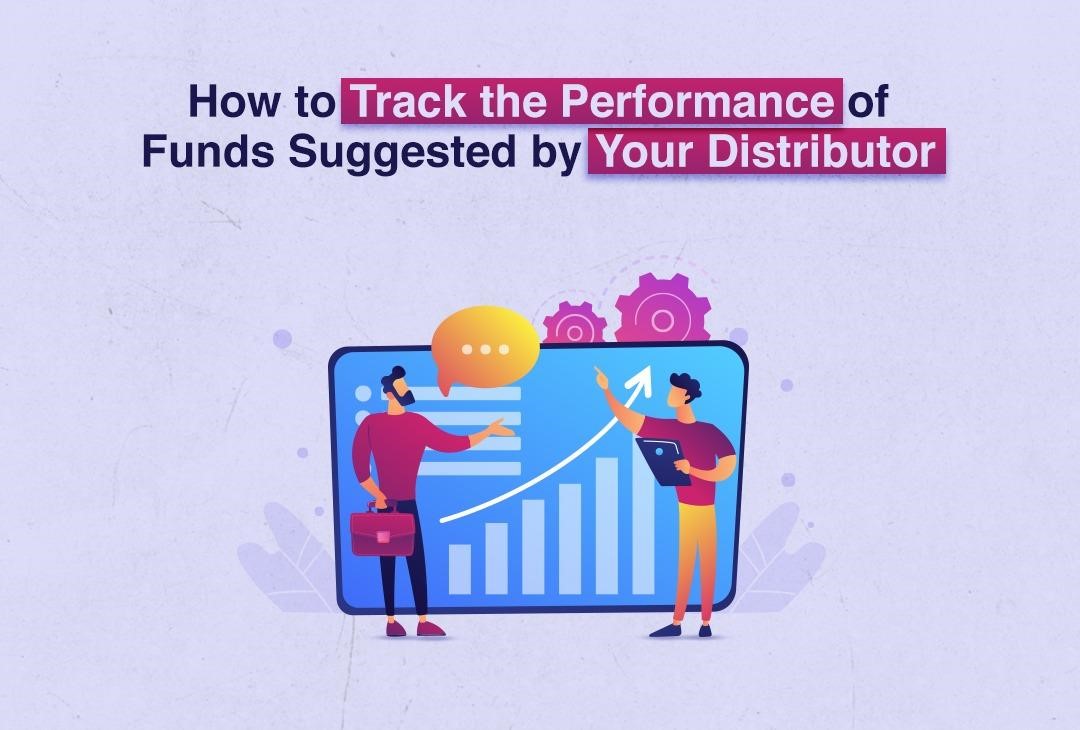How to Track the Performance of Funds Suggested by Your Distributor

Working with a mutual fund distributor (MFD) offers many benefits – from expert guidance to personalized fund selection based on your financial objectives and risk tolerance.
A good MFD helps narrow down the right schemes for you from thousands of mutual fund options available in the market.
However, even after receiving suggestions from your MFD, it’s important not to invest blindly. Take a moment to evaluate and track the performance of the suggested funds before you proceed.
This extra step gives you more clarity, allows you to ask informed questions, and ensures you are comfortable with your investment choices.
You can assess whether the fund aligns with your expectations before investing and continue to monitor its performance afterward.
Key factors to keep in mind while assessing a mutual fund’s performance include the following:
1. Compare Performance Against Benchmarks and Peers
Mutual fund performance is usually compared to a set benchmark. Consistent outperformance relative to the benchmark can signal a fund’s potential to generate superior returns over the long run.
In addition to comparing it to its benchmark, check how it stacks up against peer funds in the same category. This provides a fair context and helps you set realistic return expectations.
For example: If your large-cap fund returned 12% while its Nifty 50 or Nifty 100 (in case of nse) benchmark returned 10%, that’s good.
But if similar competitor funds consistently returned 13-14%, you might ask/check why yours lagged behind its peers.
If a mutual fund consistently underperforms its peers or fails to match benchmark index returns, then the fund is not worth investing in.
Don’t know your fund’s benchmark? Check this page on AMFI’s official website to find the benchmark index mapped to each mutual fund scheme.
2. Check Alpha and Beta
Alpha indicates how much a fund’s performance deviates from its benchmark – whether it has exceeded or lagged behind.
A fund showing positive alpha (above zero) has generated higher returns than its benchmark index.
For example, if a mid-cap fund earns 17% while its benchmark returns 15%, the fund has an Alpha of +2%, indicating a 2% outperformance. A higher positive alpha reflects superior performance.
Beta measures how much a fund’s performance moves relative to the market. A score above 1 means the fund tends to swing more, while below 1 indicates milder movements than the market.
It gives you a clearer picture of the potential risk tied to the fund.
For example, A Beta of 1.2 means if the market moves 10%, the fund might move 12% (more volatile). A Beta of 0.8 suggests the fund may fluctuate 20% less than the market, indicating lower volatility.
A Beta close to or under 1 suggests the fund may be less volatile – and may offer more stable, but lesser returns than higher-Beta options.
If you prefer stability, go for mutual funds with a lower beta ratio – they’re less volatile and better suited for risk-averse investors.
If you’re aiming for higher returns and can handle market swings, choose funds with a beta of 1 or more, as they tend to move more aggressively with the market.
If a fund suggested by your mutual fund distributor shows a consistently negative alpha or a beta that doesn’t suit your risk appetite, it’s worth having a conversation with them about switching to a better option.
3. Expense Ratio
The expense ratio shows the yearly cost of managing the fund, charged by the fund house. Over time, even a small increase can noticeably reduce your overall gains.
While it shouldn’t be the only factor in your decision, it’s important to compare this cost across similar funds.
For example: Let’s assume you invest ₹5,00,000 in two funds that both deliver a 12% CAGR before expenses, and you stay invested for 10 years.
| Fund Name | Gross CAGR | Expense Ratio | Net CAGR | Value After 5 Years | Value After 10 Years |
| Fund A | 12% | 1.00% | 11.00% | ₹8.43 lakh | ₹14.19 lakh |
| Fund B | 12% | 1.50% | 10.50% | ₹8.23 lakh | ₹13.57 lakh |
As shown, a 0.5% difference in the expense ratio can result in a gap of around ₹62,000 over 12% of the initial ₹5 lakh investment – in final returns over 10 years.
However, higher-cost funds may sometimes justify their fees by delivering stronger performance. Don’t judge a fund solely by its cost – instead, assess whether the returns, consistency, and other key metrics make up for the higher expense ratio.
4. Evaluate Risk-Adjusted Returns
Not all high-risk funds are worth the risk taken. Risk-adjusted returns help you assess whether the returns are reasonable for the amount of risk involved. These metrics help you evaluate risk-adjusted performance:
Sharpe Ratio: Tells you how well the fund is performing compared to the risk it’s taking.
→ Higher is better – it means you’re getting more return for the risk taken.
→ A low Sharpe Ratio signals that the returns you’re getting may not be worth the risk involved.
Standard Deviation: Standard deviation tracks how much a fund’s returns swing over time.
→ Lower is better – steadier and more predictable the performance tends to be.
→ Higher means more ups and downs, which implies greater uncertainty.
Beta: As discussed above, helps understand the fund’s sensitivity to market movements.
→ A Beta of 1 means the fund mirrors market movements
→ Above 1 signals higher volatility.
→ Below 1 indicates more stability than the broader market.
Beta just shows how aggressive or conservative the fund is, so choose based on how much risk you’re comfortable taking.
Together, these metrics offer a clear picture of whether the fund’s returns justify the level of risk you’re taking on.
5. Portfolio Turnover Ratio (PTR)
The Portfolio Turnover Ratio (PTR) shows how often the fund manager buys and sells securities within the fund during a year.
- A high PTR means the fund is actively traded, which could lead to higher transaction costs and may increase the overall expense ratio.
- A low PTR suggests a long-term, stable strategy with fewer trades.
If you’re a long-term investor who prefers stability, a low PTR may suit you better—it reflects a buy-and-hold approach.
But if you’re comfortable with frequent portfolio changes and aiming to benefit from short-term opportunities, a higher PTR might be a better fit.
Apart from these key metrics, it’s important to remember that numbers alone don’t tell the full story. To get a comprehensive view of a mutual fund’s performance, you should also consider qualitative factors that influence how the fund is managed and performs over time.
6. Compare Fund Returns Across Market Phases and Time Frames
Judging a mutual fund solely on recent performance is one of the most common investor mistakes.
A scheme may show strong short-term returns due to a sudden market rally or sector-specific momentum – but that doesn’t speak for its long-term reliability. (And of course, no return is ever guaranteed.)
To make a better-informed choice, assess the fund’s returns across multiple time frames – 1 year, 3 years, 5 years, and since inception.
More importantly, evaluate how it fared during different market cycles – like bull runs, market corrections, and volatile periods (for equity funds); or rising and falling interest rate environments (for debt funds).
A fund that holds up well across these phases reflects the strength of its investment approach and the fund manager’s ability to adapt to changing conditions.
That consistency counts more than isolated short-term gains, especially if you’re aiming for long-term stability.
7. The Fund Manager and Fund House
Beyond numbers, the person managing your money matters. A fund manager’s experience, track record, and the performance of other schemes they handle can give you insight into their investment style and consistency.
A skilled and experienced manager often adds value through timely decisions and a disciplined approach.
Also, consider the reputation and track record of the fund house. A well-regarded fund house with consistent performance and strong governance builds greater trust in the scheme.
The Habit That Helps Your Funds Grow
Keep in mind, your review shouldn’t stop once you’ve invested.
When you rebalance your portfolio or your financial goals change, and you adjust your asset allocation, make sure to communicate clearly with your distributor..
Review the key metrics of the funds they suggest during these discussions.
Make it a habit to review your mutual fund investments at least quarterly and assess their performance carefully.
While short-term market movements can be unpredictable, regular monitoring helps you stay informed and make better decisions aligned with your long-term goals.
It also helps you decide whether to stay invested, rebalance, or switch schemes- especially if your financial situation or market conditions have changed.
Where to Find These Mutual Fund Details
You can access most of these details through a mutual fund’s fact sheet, a monthly document released by every mutual fund house. Think of it as a report card for each scheme, summarizing its key features, performance, and portfolio holdings.
It’s a valuable resource for:
- New investors trying to evaluate a scheme before investing.
- Existing investors who want to keep track of how their fund is performing.
A typical fund fact sheet includes:
- Basic Scheme Info: Scheme name, category, launch date, fund manager name and experience, investment objective.
- Assets Under Management (AUM): Average and latest AUM.
- Net Asset Value (NAV): Latest NAV per unit.
- Expense Details: Total Expense Ratio (TER) for both regular and direct plans.
- Benchmark & Load Info
- Performance Data: Returns over 1, 3, 5 years and since inception. SIP performance may also be included.
- Risk Metrics: Standard deviation, Sharpe ratio, beta, and portfolio turnover (for equity funds); modified duration and average maturity (for debt funds).
- Portfolio Insights: Asset allocation, sector and credit quality breakdowns, list of top holdings, etc.
A mutual fund fact sheet provides all the essential details you need to assess a fund on your own – whether you’re evaluating one suggested by your distributor, reviewing your portfolio, or making adjustments based on changing financial goals
Where to Find Mutual Fund Fact Sheets?
You can request the fact sheet of the suggested funds directly from your distributor. Alternatively, fact sheets are readily available on the official websites of mutual fund houses – typically under sections like “Downloads” or “Resources.”
For quick access, you can also visit the AMFI – Download Monthly MF Fact Sheets page, which provides direct links to the fact sheet pages of most fund houses.
You can also view key fund details, performance metrics, and peer comparisons on mutual fund investment platforms like Moolaah, which make it easier to evaluate and compare funds before investing.
Read Next – How to Choose the Right Mutual Fund Distributor for Your Investment Goals?
FAQ
How to track the performance of mutual funds suggested by a distributor?
To track mutual funds suggested by your distributor, review the fund’s fact sheet and check key metrics like past returns, alpha, beta, Sharpe ratio, and expense ratio. Compare them with the benchmark and other funds in the same category to understand how well the fund is performing.
Why should I assess mutual funds suggested by my distributor?
Your distributor suggests funds based on your goals and risk profile, but reviewing them yourself helps you stay engaged in the process. It builds your confidence, encourages open discussions, and ensures you stay aligned with your investment journey – especially if your financial needs or market conditions change.
What are the key metrics to evaluate mutual fund performance?
Focus on metrics like:
- Returns over different time frames
- Alpha and beta
- Sharpe ratio and standard deviation
- Expense ratio
- Portfolio turnover ratio (PTR)
These help you judge both returns and the level of risk involved.
What is a good alpha and beta in mutual funds?
A positive alpha shows that the fund has outperformed its benchmark. A beta below 1 means lower volatility than the market, ideal for conservative investors. A beta above 1 indicates higher risk and is better suited for aggressive investors.
How often should I review mutual fund performance?
You can review your mutual fund portfolio at least once every quarter. However, rebalancing or deeper reviews should be done earlier if there are major changes in your financial goals, market conditions, or personal circumstances. Staying proactive helps you and your distributor make timely adjustments to stay on track.
Does a high expense ratio reduce mutual fund returns?
Yes. A high expense ratio can reduce the overall return you earn from a fund. But if the fund has a strong performance track record, the cost may be justified. Always compare with similar funds to understand if you’re getting value for the fees.
What does the portfolio turnover ratio (PTR) mean in mutual funds?
PTR shows how frequently a fund manager buys and sells securities. A low PTR reflects a stable, long-term strategy. A high PTR suggests active trading and may suit investors looking for short-term opportunities.
Where can I find data to track mutual fund performance?
You can track mutual fund performance through fact sheets published by fund houses on their official websites. These include returns, portfolio holdings, and risk ratios. Your mutual fund distributor (MFD) can help you access and interpret these documents. You can also visit the official AMFI website (www.amfiindia.com) to get direct links to fact sheet pages of various fund houses.



